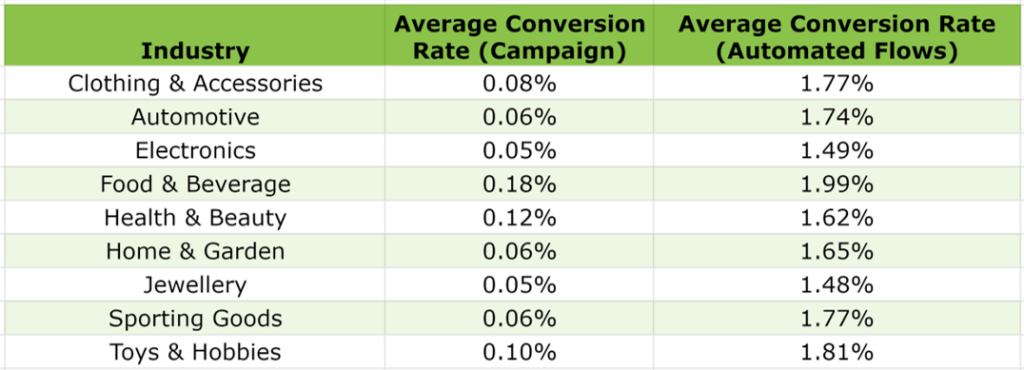- Home
- Statistics and Analytics
- Email Conversion Rate: The Ult ...

The conversion rate is a key performance indicator in email marketing. It measures the effectiveness of your email campaign. With this metric, marketers get to see how their email content resonates with the audience and if it drives desired action.
A higher conversion rate means that your email campaign is doing well and your subscribers are responding to its CTAs
To drive sales and build relationships with customers, you will need to understand how conversion rates work – and what you can do to improve them.
What Is Email Marketing Conversion Rate?
Email marketing conversion rates measure the percentage of people who have received your email and went on to take a specific action. This could be anything from making a purchase to signing up for a subscription or downloading a piece of content.
Here’s the formula for calculating the email marketing conversion rate:
- Number of conversions is the total number of times your readers acted upon your CTAs after clicking through from the email.
- Number of delivered emails is the total number of emails that were successfully delivered to the recipient’s inbox (excluding bounced emails).
For example, if you sent your email to 2,000 subscribers, and 100 of those subscribers went on to make a purchase by clicking the link in that email, your conversion rate would be:
(100÷2000) × 100 = 5%
What Is a Good Email Marketing Conversion Rate?
What makes a “good” email marketing conversion rate can vary a lot depending on several factors. These include the industry, the target audience, the type of email sent (e.g., newsletter, promotional, transactional), and the specific action desired (e.g., purchase, sign-up, download).
To give a general benchmark, average email marketing conversion rates typically range from about 1% to 5%. According to the research, the average conversion rate for email campaigns across all industries is 0.09%, with top performers achieving 0.47%, while the average open rate for automated email flows is 1.71%, with top performers reaching as high as 5.71%.
Here’s how conversion rates vary according to the industry:

Certain industries may be seeing higher averages. This could be because of the nature of their audience and the relevancy of their offers.
For example, retail, ecommerce, and travel industries might be looking at higher conversion rates with their promotional emails.
Meanwhile, B2B (business-to-business) emails, especially those that aim for high-value conversions like software subscriptions or professional services, might have lower conversion rates – but with a higher value per conversion.
Types of Conversions in Email Marketing
In email marketing, the term “conversion” can describe different actions that a customer may take in response to an email.
These actions can range from low-commitment activities (such as clicking a link) to high-commitment decisions (such as making a purchase).
Here are several common types of conversions in email marketing:
- Content downloads: If your email promotes downloadable content (like whitepapers, e-books, or guides), your conversion could look like readers downloading the offered content.
- Event registrations: For emails promoting webinars, workshops, or other events, conversions often come as the number of registrations.
- Survey or feedback submission: If your goal is to collect customer feedback via surveys, a recipient completing and submitting these forms counts as a conversion.
- Account sign-ups or subscriptions: This includes new users signing up for your service, subscribers joining your mailing list, or existing users upgrading their accounts or subscriptions.
- Social media engagement: If your email encourages recipients to follow your social media profiles or engage with your content on those platforms, such actions can be considered conversions.
- Sales/purchases: Often the ultimate conversion goal, this measures the number of recipients who make a purchase as a direct result of the email.
- Lead generation: For B2B companies, a conversion might mean filling out a contact form, requesting a demo, or any other action that shows interest in becoming a sales lead.
- Renewals or re-engagements: With some campaigns (especially those that target existing customers), the goal may be to inspire renewals, re-engagements, or reactivations of subscriptions or services.
How to Increase a Conversion Rate in Email Marketing
To get a higher conversion rate, marketers will need to look into various elements of their email campaigns.
Here are several strategies to consider:
- Segment your audience: Split your email list into smaller segments. This segmentation may be based on demographics, purchase history, behavior, or other criteria. When you tailor messages to make them more relevant, you are far more likely to get conversions.
- Personalize your emails: Go deeper than just using the recipient’s name in your emails. Tailor your content based on your readers’ earlier interactions, known preferences, and behavior.
- Craft compelling subject lines: Your subject line is the first impression. Make it intriguing, clear, and relevant.
- Optimize email content: Ensure your email content is engaging, concise, and provides clear value. Use compelling visuals and strong calls to action (CTAs) that stand out and direct recipients towards the desired action.
- Use A/B testing: Experiment with different elements of your email. Try using different subject lines, email layouts, CTA buttons, and send times. Look into the results and see what works best for your readership.
- Mobile optimization: Most people prefer to open their emails on mobile devices. This is why your emails and landing pages should be mobile-friendly.
- Improve landing pages: Ensure the landing page linked from your email is optimized for conversions. It should be relevant to the email content, have a clear value proposition, and include a straightforward form or purchase process.
- Offer incentives: Discounts, free trials, bonuses, and other incentives can motivate recipients to take action. Make sure the offer is clear and compelling.
- Reduce friction: Identify and remove any barriers that might prevent a conversion. This could include simplifying the checkout process, offering more payment options, or providing more information to answer potential questions.
- Follow up: Send follow-up emails to recipients who didn’t convert on the first attempt. This can include additional information, answers to common objections, or a reminder of the offer’s expiry.
- Leverage social proof: Add testimonials, reviews, or case studies in your emails. This is a good way to build trust and credibility. When people see that others have had positive experiences can inspire conversions.
- Monitor and analyze performance: Regularly review your performance metrics. This will let you see what is working and what isn’t. Use these insights to refine your strategies continually.
Calculating and Monitoring Conversion Rates in Email Marketing Campaigns
There are lots of reasons why you should absolutely calculate and track your conversion rates:
- Measure campaign effectiveness: Conversion rates give a clear picture of how your email campaigns are doing. This is the metric you need to analyze to see if your content resonates with your readership.
- ROI analysis: When you know your conversion rates, you can better assess the financial performance of your email marketing campaigns. You will see how much revenue each campaign generates relative to how much you have invested.
- Audience insights: Monitoring conversion rates can reveal valuable insights about your audience’s preferences and behaviors. Analyzing which types of emails (e.g., promotional, informational, personalized) lead to higher conversions can guide your content strategy and segmentation approach.
- Optimization opportunities: Tracking conversion rates over time will let you identify trends and pinpoint areas for improvement.
- Benchmarking success: Conversion rates serve as a benchmark for your email marketing success. They let you set realistic goals based on past performance and industry standards.
- Enhance customer experience: When you understand what types of emails convert, you get to better tailor your upcoming communications to match what your audience is interested in.
- Resource allocation: Knowing your conversion rates helps you allocate your marketing resources more effectively. You can focus your efforts and budget on the strategies and campaigns that have proven to drive conversions, thereby maximizing your marketing efficiency.
- Competitive advantage: In competitive markets, having a higher conversion can mean even more. It shows that your email marketing strategies are more effective than those used by your competitors.
- Long-term planning: When you track conversion rates consistently, you can make more strategic long-term plans. It gives you a historical data trend that can help predict future performance.
Common Email Marketing Mistakes That Hurt Conversion Rates
There are some mistakes that can have a particularly negative effect on conversion rates. Here’s a closer look at some of these very mistakes and ways to avoid them:
1. Neglecting email list segmentation
One of the most critical errors in email marketing is failing to segment your email list. Sending the same message to your entire list will almost always lead to lower engagement.
Solution: Use the criteria such as demographics, purchase history, and engagement level. Tailored messages to specific segments increase relevance and drive higher conversions.
2. Overlooking personalization
Beyond addressing recipients by their name, a lack of deeper personalization can make your emails feel generic and impersonal.
Solution: Use data insights to craft messages that resonate with individual preferences, past interactions, and behaviors. Personalization can significantly enhance the recipient’s connection to your brand, leading to higher conversion rates.
3. Using unclear or weak CTAs
A common mistake is having CTAs that are either not clear about the action you want the recipient to take or are too weak to motivate action.
Solution: Make your CTAs compelling, clear, and visually distinct. Use action-based language and make it very easy and straightforward for readers to understand what they should do next.
4. Ignoring mobile optimization
People tend to read emails on mobile devices. If your email content is not optimized for mobile devices, your campaign may just not be as effective as it could be.
Solution: Design emails with a mobile-first approach, ensuring they are readable and engaging on smaller screens. Use responsive design to adjust content layout based on the device’s screen size.
5. Overloading emails with content
Sending out emails with too much information or too many choices is a sure way to overwhelm your audience.
Solution: Keep your emails concise and focused. Highlight one main offer or message and guide recipients towards a single call to action.
6. Not testing emails before sending
Sending emails without thorough testing can result in formatting issues, broken links, or other errors that detract from the user experience and credibility.
Solution: Always conduct A/B testing on different elements of your emails, including subject lines, content, and CTAs, to see what resonates best with your audience. Additionally, use email previews to check how your emails look on different devices and email clients.
7. Ignoring email deliverability
Issues with email deliverability, such as landing in the spam folder, can drastically reduce your campaign’s reach and effectiveness.
Solution: Maintain a healthy sender reputation by following best practices for email marketing, regularly cleaning your email list, and encouraging subscribers to whitelist your emails.
8. Failing to analyze performance data
If you don’t track or analyze how your email campaigns are doing, you will be leaving yourself in the dark as to what works and what doesn’t.
Solution: Use analytics to measure key performance indicators (KPIs) like open rates, click-through rates, and conversion rates.
To Sum Up
Getting a better conversion rate takes time. Try new things, learn from your mistakes, and adapt to what your audience likes. The goal is not just to increase sales but to build trust and deliver value. This strengthens your brand and improves conversion rates.



